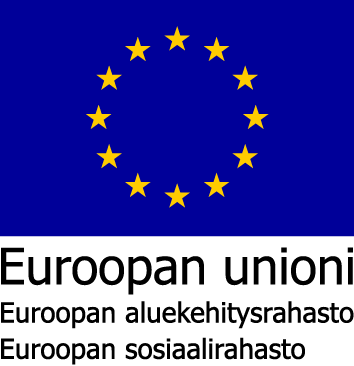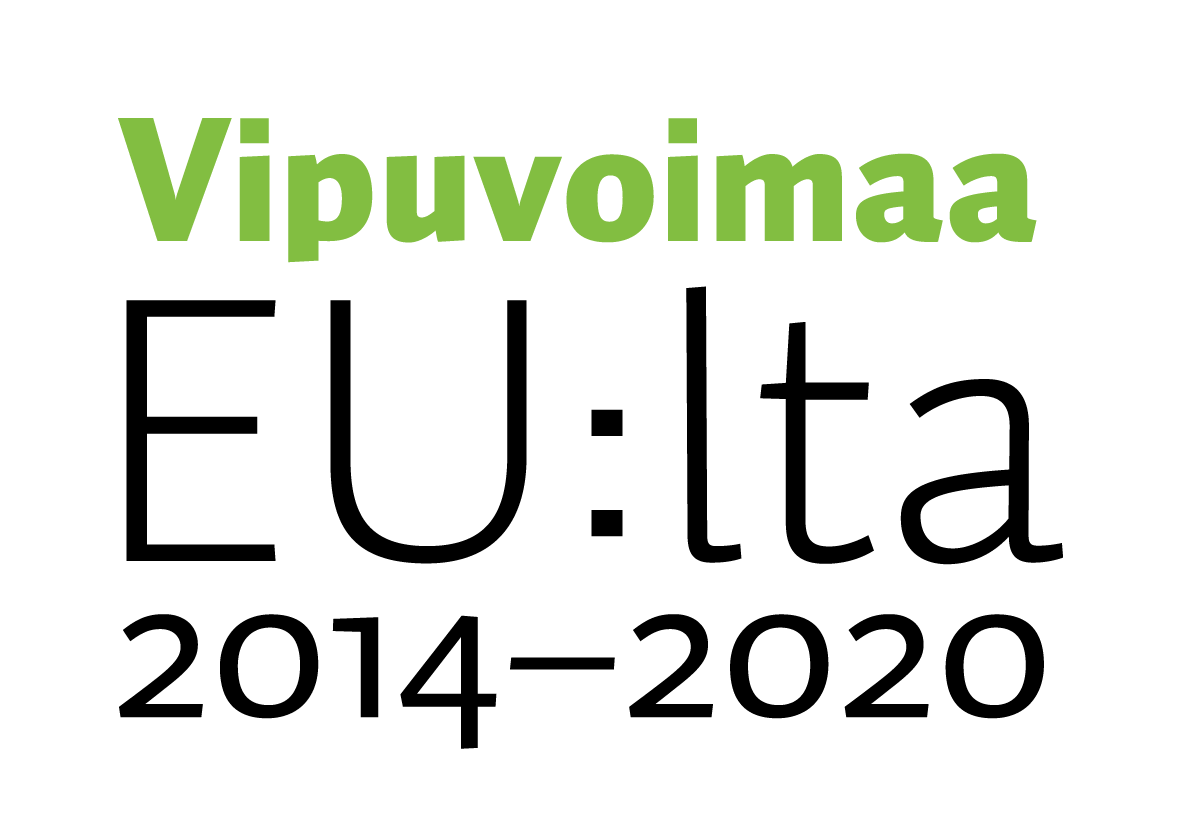

 |
 |
Hankekoodi: A75251
Hankkeen nimi: DiVes - Digitalisaation ja IoT:n hyödyntäminen veden käyttöön ja tuotantoon liittyvissä ekosysteemeissä
Toimintalinja: 2. Uusimman tiedon ja osaamisen tuottaminen ja hyödyntäminen
Erityistavoite: 5.1. Yritysten innovaatiotoiminnan vahvistaminen
Suunnitelman mukainen toteutusaika: Alkaa 1.6.2019 ja päättyy 31.5.2023
Toiminnan tila: Toiminta päättynyt
Vastuuviranomainen: Keski-Pohjanmaan liitto
Hakijan virallinen nimi: Jyväskylän yliopisto
Organisaatiotyyppi: Yliopisto
Y-tunnus: 0245894-7
Jakeluosoite: Kirjaamo, PL 35, 40014 Jyväskylän yliopisto (toteutuspaikka: Kokkolan yliopistokeskus Chydenius)
Puhelinnumero: 06-8294111 (keskus)
Postinumero: 67100
Postitoimipaikka: Kokkola
WWW-osoite: http://www.chydenius.fi
Hankkeen yhteyshenkilön nimi: Veli-Matti Tornikoski
Yhteyshenkilön asema hakijaorganisaatiossa: Projektipäällikkö
Yhteyshenkilön sähköpostisoite: veli-matti.tornikoski(at)jyu.fi
Yhteyshenkilön puhelinnumero: +358 40 075 3860
Hakijoiden lukumäärä tai tuen siirto -menettely:
Puhdas vesi on maailman tärkein luonnonvara. Puhtaan veden tuottaminen sitä tarvitseville ja käyttäville ihmisille on vaatinut monimutkaisten järjestelmien ja prosessien kehittymisen aikojen kuluessa. Puhtaan veden tuottamisessa sekä tuotannon prosesseissa ja hallinnassa on mahdollista hyödyntää uutta teknologiaa. Tavoitteellisesti tietotekniikkaa hyödyntämällä voidaan kehittää kaupunkeja älykkäimmiksi sekä kestävän kehityksen mukaisiksi, esimerkiksi vesihuollon osalta.
Suomen vesihuoltopalvelut kuuluvat tällä hetkellä kiistatta maailman kärkijoukkoon. Vesihuollon hyvän tason ylläpitäminen vaatii kuitenkin jatkuvaa panostusta ja toiminnan kehittämistä. Koska vesihuollon tekniset investoinnit ovat pitkäikäisiä, vesihuollon kehittämistä on tarkasteltava kauaskantoisesti ja otettava huomioon myös tietotekniikan kehittyminen. Veteen liittyvää digitaalista osaamista, osana Cleantechia, on mahdollista edelleen kehittää ja myös viedä ulkomaille.
IoT:n olemukseen kuuluu erilaisten laitteiden ja asioiden kytkentäisyys toisiinsa ja internetiin erilaisten verkkojen avulla. Laitteet ja asiat, kommunikoimalla toistensa kanssa, luovat uusia palveluita kommunikaation ja tiedon vaihdannan päälle. Vesihuoltoon liittyy useita eri osa-alueita, joita teknologian ja IoT:n kehitys koskettaa. Osa-alueet toistuvat usein myös samanlaisina muualla, joten paikallisesti toteutetut pilotit ja kokeilut voivat tuottaa muuallakin toimivia potentiaalisia innovaatioita, menetelmiä, prosesseja, palveluja ym. joita voidaan tuotteistaa ja viedä ulkomaille.
Älykäs vedenhallinta konseptina ei ole pelkästään vesiresurssien varastosta kulutukseen siirtymisen tarkkailua ja monitorointia tai pelkkää loppuasiakkaiden kulutustietojen etäluentaa. Sen voitaisiin nähdä ulottuvan aina veden alkulähteille ja siitä käsittelyn ja jakelun kautta kulutukseen ja edelleen takaisin käsittelyyn. Kaiken keskiössä älykkäässä veden kiertokulussa on kuitenkin luotettava ja nopea informaation kulku, joka tuotetaan tietotekniikan ratkaisujen avulla.
Cleantech eli "puhdas teknologia" tarkoittaa tuotteita, palveluita, prosesseja ja teknologioita, jotka edistävät luonnonvarojen kestävää käyttöä ja ehkäisevät tai vähentävät liiketoiminnan kielteisiä ympäristövaikutuksia. Veteen liittyvä osaaminen luokitellaan osaksi cleantechia, ja Suomen tasollakin esimerkiksi kaivostoiminnan ja maaperän louhimiseen liittyvässä toiminnassa on usein suuren mittakaavan riskejä, jotka liittyvät veteen sekä kielteisiin ympäristövaikutuksiin. Lisäksi Keski-Pohjanmaan alueen maataloudessa pitää nyt ja tulevaisuudessa keskittyä mm. vesipäästöjen hallintaan, ottamalla esim. kiertotalouden ratkaisut huomioon.
DIVES-projektin tavoitteena on selvittää Keski-Pohjanmaalla veteen liittyvien toimijoiden veden käyttöön ja tuotantoon liittyvien ekosysteemien tilaa sekä haasteita ja tuottaa uutta soveltavaan tutkimukseen perustuvaa tietoa niihin liittyen, kuten veden monitorointiin, käsittelyyn sekä puhtaan veden tuotantoon, jakeluun ja käsittelyyn liittyvistä digitalisaation ja cleantechin teknologioista, menetelmistä ja prosesseista, jotka edistävät vesiluonnonvarojen kestävää käyttöä ja ehkäisevät myös toiminnan kielteisiä ympäristövaikutuksia. Projektissa on tavoitteena perehtyä IoT teknologioihin, sen mahdollistamiin vesihuollon ja puhtaan veden tuottamisen ratkaisuihin ja ekosysteemeihin, joita käytetään tai joita olisi mahdollista käyttää vesihuollon alalla ja toteuttaa erilaisia pilotteja vesihuoltoon liittyvien toimijoiden kanssa, joilla etsitään uusia tulevaisuuden tehokkaita toimintatapoja. Tavoitteena on myös laajentaa ja parantaa yliopiston langattomien teknologioiden ja IoT:n t&k-ympäristöä älykkään erikoistumisen kautta uudelle toimialalle ja uusien tahojen hyödynnettäväksi.
Projektin tuloksena saadaan uusinta tietoa alueen vesiosaamiseen mahdollisuuksista ja veden käyttöön ja tuotantoon liittyvien ekosysteemien tilasta. Lisäksi saadaan uutta osaamista ja tietämystä digitalisaation ja IoT:n soveltamisesta sekä ratkaisuista, jotka liittyvät cleantechiin vesiosaamisen osalta. Tuloksena yliopiston langattomien teknologioiden ja IoT:n t&k-ympäristö kehittyy ja laajenee älykkään erikoistumisen kautta uudelle toimialalle ja uusien tahojen hyödynnettäväksi. Yhteistyö uusien toimijoiden kanssa lisääntyy ja näin digitalisaatiota ja langattomien teknologioiden osaamista yhdistämällä vesiosaamisen aloihin saadaan muodostettua uusi osaamiskeskittymä. T&k ympäristöä laajentamalla ja hyödyntämällä saadaan toteutettua uusia pilotteja, jotka mahdollistavat uuden tiedon ja osaamisen tuottamisen osaamiskeskittymään ja sen sidosryhmille kuin myös uusien innovaatioiden ja liiketoimintaideoidenkin syntymisenkin. Projektissa saadaan kokonaisuutena uusi veteen, langattomiin teknologioihin ja IoT:hen liittyvä tutkimus-, koulutus ja kehittämisympäristö.
Projektin pääasiallinen kohderyhmä on vesihuoltoon, veden käsittelyyn ja käyttöön sekä puhtaan veden tuottamiseen ja jakeluun liittyvät organisaatiot sekä näiden osalta osaamistaan kasvattavat tutkimus- ja koulutusorganisaatiot. Lisäksi kohderyhmään kuuluu myös yritykset, jotka tarjoavat IoT- tai Cleantech- tuotteita, palveluja, prosesseja tai teknologioita veden käyttöön ja tuotantoon liittyvien ekosysteemien tarpeisiin.
Välillisenä kohderyhmänä ovat veden käyttöön ja tuotantoon liittyvien ekosysteemien loppukäyttäjät, kuten talousveden käyttäjät kotitalouksissa sekä yrityksissä.
Välillisenä kohderyhmänä ovat myös IoT verkkoja, kuten LoRaWAN, Sigfox, 5G, Lte ja NB-IoT, tarjoavat organisaatiot.
Myönnetty EU- ja valtion rahoitus: 251 762
Toteutunut EU- ja valtion rahoitus: 251 127
Suunniteltu julkinen rahoitus yhteensä: 325 831
Toteutunut julkinen rahoitus yhteensä: 325 335
Maakunnat: Keski-Pohjanmaa
Seutukunnat: Kaustisen, Kokkolan
Kunnat: Lestijärvi, Toholampi, Kaustinen, Veteli, Perho, Kokkola, Kannus, Halsua
Jakeluosoite:
Postinumero:
Postitoimipaikka:
Suunniteltu: 0, joihin työllistyvät naiset 0
Toteutunut seurantatietojen mukaan: 0.00, joihin työllistyvät naiset 0.00
Suunniteltu: 0, joista naisten perustamia 0
Toteutunut seurantatietojen mukaan: 0.00, joista naisten perustamia 0.00
| Välitön | Välillinen | |
| Ekologinen kestävyys | ||
| Luonnonvarojen käytön kestävyys | 7 | 5 |
| Projektissa on yhtenä tavoitteena perehtyä IoT teknologioihin, sen mahdollistamiin vesihuollon ja puhtaan veden tuottamisen ratkaisuihin ja ekosysteemeihin, joita käytetään tai joita olisi mahdollista käyttää vesihuollon alalla ja toteuttaa erilaisia pilotteja vesihuoltoon liittyvien toimijoiden kanssa, joilla etsitään uusia tulevaisuuden tehokkaita toimintatapoja. | ||
| Ilmastonmuutoksen aiheuttamien riskien vähentäminen | 2 | 3 |
| Projektin tuomat uudet seuranta- ja mittausarvot voivat edesauttaa tuotantolaitosten prosessien säätöä ja siten vähentää luontoon kohdistuvia rasituksia. | ||
| Kasvillisuus, eliöt ja luonnon monimuotoisuus | 2 | 1 |
| Projektin tuomat uudet seuranta- ja mittausarvot voivat edesauttaa tuotantolaitosten prosessien säätöä ja siten vähentää luontoon kohdistuvia rasituksia. | ||
| Pinta- ja pohjavedet, maaperä sekä ilma (ja kasvihuonekaasujen väheneminen) | 8 | 7 |
| Projektissa on yhtenä tavoitteena perehtyä IoT teknologioihin, sen mahdollistamiin vesihuollon ja puhtaan veden tuottamisen ratkaisuihin ja ekosysteemeihin, joita käytetään tai joita olisi mahdollista käyttää vesihuollon alalla ja toteuttaa erilaisia pilotteja vesihuoltoon liittyvien toimijoiden kanssa, joilla etsitään uusia tulevaisuuden tehokkaita toimintatapoja. | ||
| Natura 2000 -ohjelman kohteet | 0 | 0 |
| Projektilla ei ole yhteyttä Natura 2000 -ohjelman kohteisiin. | ||
| Taloudellinen kestävyys | ||
| Materiaalit ja jätteet | 0 | 0 |
| Projektilla ei ole vaikutusta materiaalien kierrätykseen tai hyötykäyttöön. | ||
| Uusiutuvien energialähteiden käyttö | 2 | 1 |
| Projektin mittausverkoissa on mahdollista käyttää mm. aurinkopaneeleita virranlähteenä. | ||
| Paikallisen elinkeinorakenteen kestävä kehittäminen | 4 | 3 |
| Projektin avulla paikallista osaamista pyritään kasvattamaan, jolloin paikallisen liiketoiminnan ja elinkeinorakenteen kehittyminen on mahdollista. | ||
| Aineettomien tuotteiden ja palvelujen kehittäminen | 4 | 2 |
| Projektissa kehitetään älykkään mittausjärjestelmän ja verkkoportaalin ratkaisuja, joihin sisältyy aineettomia tuotoksia. | ||
| Liikkuminen ja logistiikka | 3 | 2 |
| Järjestelmän tuottamat monitorointi ja mittaustulokset voivat vähentää mm. ajoneuvoilla tehtäviä käyntejä mittauskohteisiin, jatkuva-aikaisen ja reaaliaisen mittaustulosten tullessa verkkoportaaliin. | ||
| Sosiaalinen ja kulttuurinen kestävyys sekä yhdenvertaisuus | ||
| Hyvinvoinnin edistäminen | 2 | 3 |
| Projektin tuomat uudet seuranta- ja mittausarvot voivat edesauttaa tuotantolaitosten prosessien säätöä ja siten vähentää luontoon kohdistuvia rasituksia. | ||
| Tasa-arvon edistäminen | 0 | 0 |
| Projektissa ei suoranaisesti ole yhteyttä tasa-arvon kehittämiseen. | ||
| Yhteiskunnallinen ja kulttuurinen yhdenvertaisuus | 2 | 1 |
| Projektin tavoitteena on tarjota kaikille yhdenvertainen mahdollisuus päästä tarkastelemaan julkisia mittaus- ja monitorointituloksia. | ||
| Kulttuuriympäristö | 1 | 1 |
| Projektin tuomat uudet seuranta- ja mittausarvot voivat edesauttaa tuotantolaitosten prosessien säätöä ja siten vähentää luontoon kohdistuvia rasituksia. | ||
| Ympäristöosaaminen | 7 | 6 |
| Projektissa on tarkoitus pilotoida uusinta teknologiaa erilaisten kenttäkokeilujen avulla, joissa etsitään toimivia tulevaisuuden cleantech-ratkaisuja vesiosaamiseen liittyviin toimintaympäristöihin sekä todentaa erilaisten ratkaisujen ja järjestelmien soveltuvuutta erilaisissa vesiekosysteemeissä. Projektin tuloksia esitellään kansallisissa ja kansainvälissä konferensseissa ja erilaisissa tapahtumissa. | ||
DIVES-projektin tavoitteena oli vahvistaa Keski-Pohjanmaalla toimivien veteen liittyvien toimijoiden innovaatiotoimintaa sekä uusien digitaalisten teknologioiden hyödyntämistä. Hankkeen alkuvaiheessa kerättiin tietoa veden ekosysteemin toimijoiden toiminnan nykytilasta ja haasteista. Projektissa tarkistelun kohteena oli etenkin digitalisaation ja cleantechin teknologioiden hyödyntäminen veden monitorointiin, käsittelyyn, puhtaan veden tuotantoon ja jakeluun liittyvillä aihealueilla. Projekti hankki tietoa sovellusalueista ja niihin soveltuvista teknologioista. Uuden, ketterän kokeilevan tutkimuksen kautta syntyvän tietotaidon tuottamiseksi toteutettiin projektin aikana vesidatan pilottialusta, jonka päälle voitiin rakentaa Keski-pohjanmaan alueella erilaisia pilotteja demonstroimaan digitalisaation ja etenkin esineiden internetin eli IoT:n mahdollisuuksia ja hyötyjä vesialan erilaisille toimijoille.
I. Toimijoiden ja ekosysteemien kartoitusta digitalisaation hyödyntämisessä.
Projektin alkuvaiheessa selvitettiin Keski-Pohjanmaan alueen veteen liittyvien ekosysteemien nykytilaa, toimintaa ja haasteita. Tästä saatiin muodostettua lähtökohta hankkeen toiminnalle. Haasteiden ja nykytilan lisäksi käytiin läpi ekosystemeeistä osa-alueita,missä olisi mahdollista hyödyntää digitalisaation tuomia ratkaisuja tai teknologioita, joko tehostamaan toimintaa tai sitten mahdollistamaan jonkin uuden asian toteuttaminen, mikä ei aiemmin ole ollut mahdollista. Hankittiin tietoa toimijoiden ympäristöistä, onko datan keräämistä käytössä ja miltä alueilta, mitä tehdään automaattisesti, miten tietoa käsitellään, tallennetaan ja analysoidaan. Lisäksi selvitettiin, millaisia asioita voitaisiin mitata veteen tai veteen liittyvään liiketoimintaan liittyen.
Tiedon keräämisen ohessa tutkittiin myös olemassa olevia teknologioita, joita käytetään tai voitaisiin käyttää veden käytön ja tuotantoon liittyvässä ratkaisuissa joihinkin olemassa oleviin ongelmakohtiin. Näissä keskityttiin etenkin IoT teknologioihin. Lisäksi hankittiin tietoa erilaisista ratkaisumalleista, joita voisi käyttää esimerkiksi vesidatan keräämiseen ja analysoimiseen. Nämä toimivat pohjatietoina ja lähtökohtana tällaisen ratkaisumallin pilotin suunnittelulle, ja niiden pohjalta toteutettiin erilaisia proof-of-concept kokeiluja ja testejä.
II. Tietoa ja osaamista
Projektin aikana toteutettiin soveltavaa tutkimusta veden monitoroinnista, käsittelystä ja puhtaan veden tuotannossa hyödynnettävistä teknologista ratkaisuista. Yhteistyössä alan asiantuntijoiden kanssa projektissa kehitettiin innovatiivisia digitalisaatioon ja IoT:hen perustuvia ratkaisuja. Tuloksena syntyi tietoa ja osaamista, joka tarjosi käytännön työkaluja vesihuollon erilaisten osa-alueiden tueksi.
III. IoT-teknologioiden tutkimus ja pilotit:
Projektin piloteissa syvennyttiin IoT-teknologioihin ja niiden mahdollisuuksiin veden käsittelyn ja tuotannon alalla. Projektin aikana toteutettiin useita pilottiprojekteja, joissa yhdessä alueen toimijoiden kanssa toteutettiin ja testattiin erilaisia ratkaisuja veden käsittelyyn, tuotantoon, kulutukseen ja monitorointiin liittyvissä prosesseissa. Näiden pilotointien avulla saatiin tietoa teknologioiden tehokkuudesta ja soveltuvuudesta käytännön tilanteissa, eri liiketoimintanäkökulmista.
IV. Yliopiston tutkimus- ja kehitysympäristön Laajentaminen:
Projektin yhtenä tavoitteena oli laajentaa yliopiston langattomien teknologioiden ja IoT:n t&k-ympäristöä vesihuollon alalle. Tämä saavutettiin älykkään erikoistumisen avulla, joka mahdollisti osaajien ja toimijoiden osallistumisen uuden toimialan tutkimukseen ja kehitykseen. Ympäristön laajentuminen loi hyvän pohjan tuleville innovaatioille ja yhteistyölle.
V. Uusien tahojen osallistuminen ja yhteistyö:
Projekti edisti yhteistyötä eri toimijoiden välillä. Uudet kumppanit ja tahot liittyivät mukaan projektin eri vaiheissa, mikä lisäsi monipuolista osaamista ja näkökulmia. Tämä yhteistyö edisti uusien ideoiden syntymistä ja avasi mahdollisuuksia liiketoimintaideoillekin.
DIVES-projekti onnistui saavuttamaan asetetut tavoitteet ja tuottamaan uutta tietoa ja osaamista digitalisaation ja IoT:n hyödyntämisestä veden tuotantoon ja käyttöön liittyvillä alueilla. Toimijoiden haasteiden kartoitus ja IoT:n mahdollisuuksien selvittäminen, tiedon ja osaamisen tuottaminen, toteutetut IoT-pilotit ja yliopistokeskuksen IoT-tutkimusympäristön laajentaminen ovat kaikki vaikuttaneet positiivisesti alueen uuden osaamisen kehitykseen. Projektin myötä syntynyt yhteistyö ja osaaminen luovat hyvän perustan tuleville kokeiluille ja innovaatioille sekä myös alueen veteen liittyvien organisaatioiden ja yritysten digitaalisen toiminnan jatkokehitykselle.
Projektin avulla on saatu edistettyä digitalisaation työkalujen hyödyntämistä toimijoiden ympäristöissä samalla kun on luotu uutta osaamista ja yhteistyömahdollisuuksia. Projektin onnistuminen on ollut mahdollista tiiviin yhteistyön, innovaatioiden ja asiantuntijuuden ansiosta.